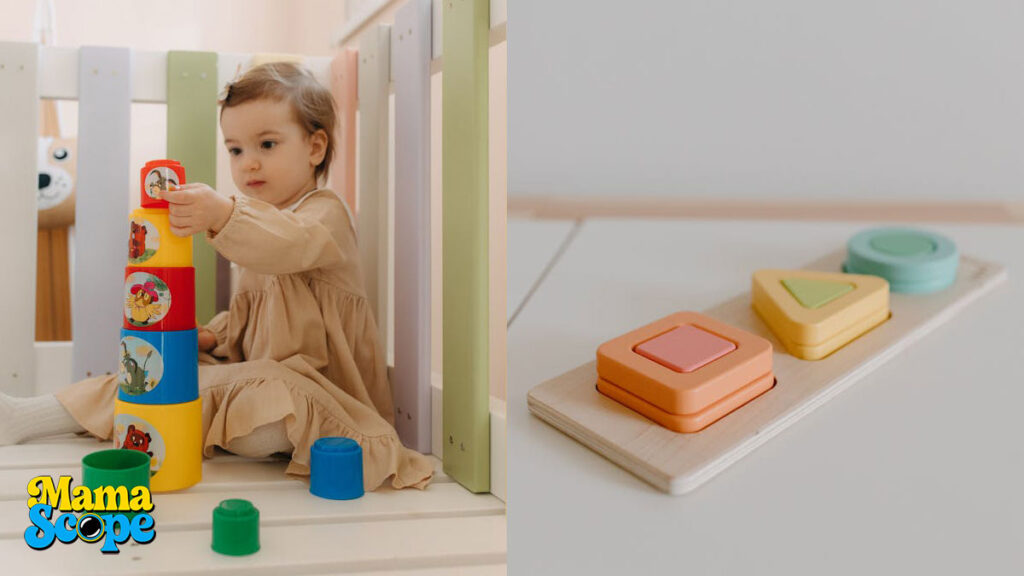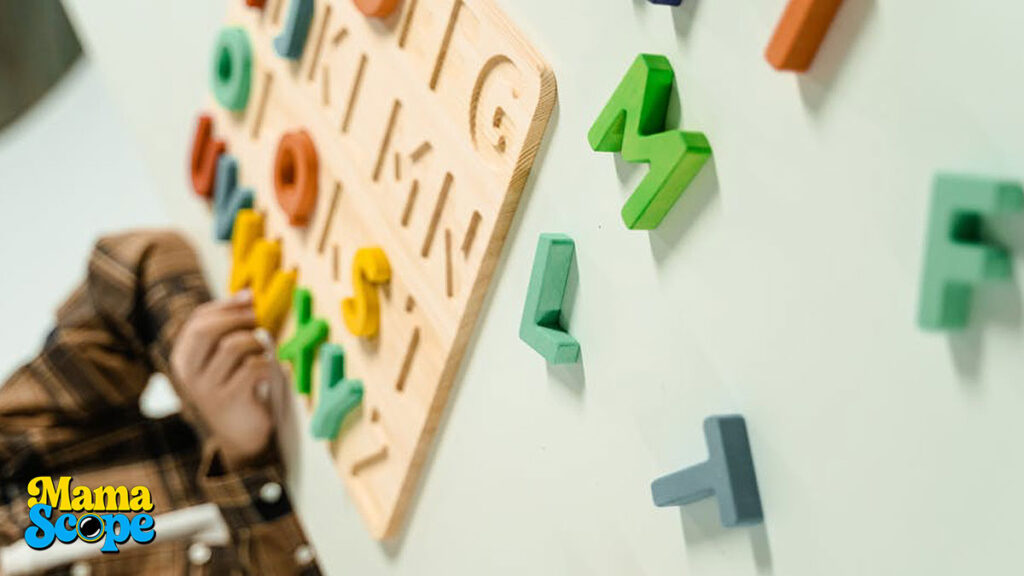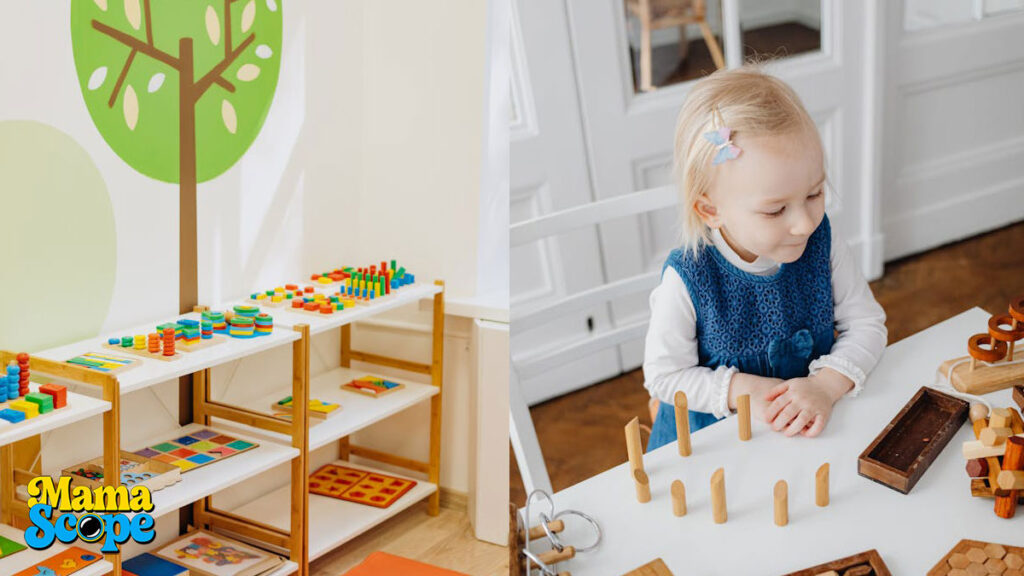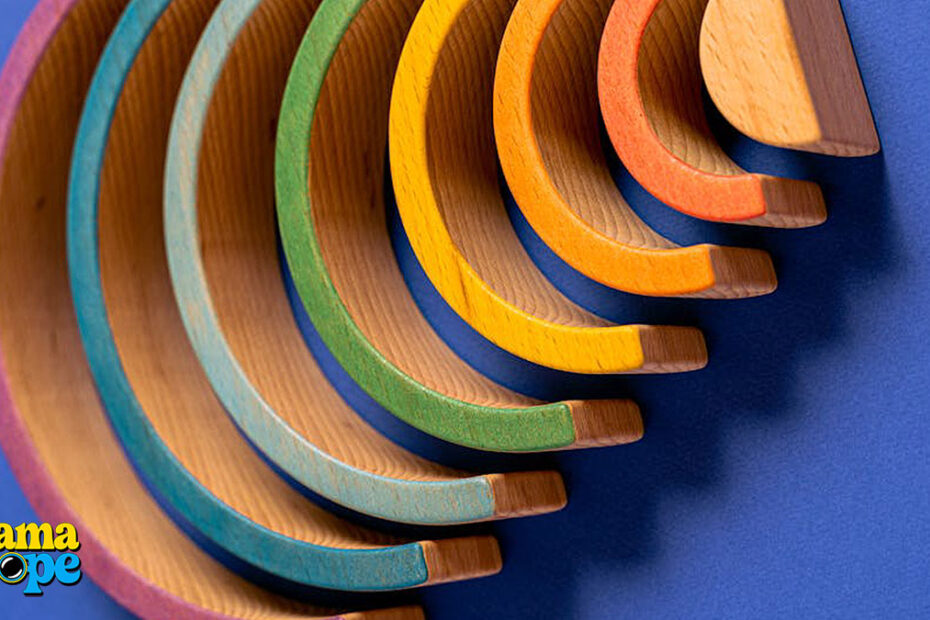Last Updated on April 25, 2025 by Mama Nova
There’s something almost magical about watching a child completely absorbed in an activity, their little hands working with purpose and their face a picture of concentration. This is the essence of Montessori learning – a child-led approach that fosters independence, curiosity, and joy in discovery. As parents, we’re always looking for meaningful ways to support our children’s development, and Montessori-inspired activities offer a beautiful framework for learning at home without turning your living room into a classroom.
The Heart of Montessori
Maria Montessori, Italy’s first female physician, developed her educational method through careful observation of how children naturally learn. She noticed that children thrive when given freedom within a prepared environment, using materials that isolate specific skills and concepts. What makes Montessori unique isn’t just the wooden materials or the child-sized furniture – it’s the profound respect for the child as a capable, curious being with an innate desire to learn.
I discovered Montessori principles when my daughter was just a toddler. Frustrated by the plastic, noisy toys that seemed to entertain her for mere minutes, I began researching alternatives. What I found changed our home life completely. By simplifying her environment and offering meaningful activities, her attention span grew, tantrums decreased, and most importantly, her natural love of learning flourished.
The beauty of Montessori is that it doesn’t require special training or expensive materials to implement at home. It’s more about shifting your perspective on how children learn and creating opportunities for them to participate in real, purposeful activities.
Creating Your Home Learning Environment
The environment plays a crucial role in Montessori education. Rather than thinking about setting up a designated “learning area,” consider how your entire home can become a learning laboratory. The kitchen offers lessons in measurement, sequence, and chemistry. The garden becomes a living science center. Even your laundry room provides opportunities for sorting, matching, and developing fine motor skills.
To make your home more conducive to Montessori-style learning, consider these environmental adjustments. Think about your child’s perspective – can they reach what they need? Are materials clearly organized and visually appealing? Is there enough space to work comfortably?
A simple low shelf where activities are displayed neatly can make a world of difference. When children can see what’s available and access it independently, they’re more likely to engage deeply with materials. Keep the selection limited – too many choices can overwhelm young children. A handful of thoughtfully chosen activities will spark more engagement than dozens of options.
One mother shared with me how transformative this simple change was: “Before, our playroom was packed with toys, but my son would dump everything and play with nothing. Now we rotate just a few activities on accessible shelves, and he spends so much more time focused on each one.”

Practical Life: Where Independence Begins
If there’s one area of Montessori that translates beautifully to home life, it’s practical life activities. These everyday tasks – pouring, scooping, cleaning, food preparation – are deeply appealing to young children who want nothing more than to do what the adults around them are doing.
In my home, I keep a low cabinet in the kitchen stocked with child-sized tools: a small pitcher, cutting board, vegetable peeler, and cleaning cloths. My daughter began making her own snacks at three years old, beaming with pride as she sliced bananas and arranged them on a plate. These aren’t just busywork activities – they build concentration, coordination, independence, and self-confidence.
The morning routine of making her bed, selecting clothes, and preparing breakfast provides numerous opportunities for learning. Yes, it takes longer when a child does these tasks themselves. Yes, the results aren’t always perfect. But the development happening during these activities is invaluable. When we step back and allow children to try, fail, adjust, and eventually succeed, we’re helping them build not just practical skills but also resilience and problem-solving abilities.
For younger toddlers, start with simple tasks like using a sponge to wipe a table, transferring water between containers, or sorting silverware. As children grow, they can take on more complex practical life work like folding clothes, preparing complete meals, or caring for plants and pets.
Sensorial Exploration: Building Cognitive Foundations
Montessori understood that children learn through their senses long before they grasp abstract concepts. The sensorial area of Montessori education helps children classify, order, and make sense of the impressions they receive from the world around them.
At home, you can support sensorial development without purchasing specialized materials. Nature provides an abundance of sensory experiences – collecting leaves of different shapes, listening to birds, feeling various textures like tree bark or smooth stones. A “mystery bag” containing objects to identify by touch alone provides a wonderful exercise in tactile discrimination.
For visual discrimination, activities as simple as sorting buttons by size or color can be deeply engaging. I created a color-matching game using paint chips from the hardware store, and my daughter returned to it repeatedly over several months, refining her ability to distinguish subtle differences in shade.
Sound cylinders can be made by filling identical containers with different materials – rice, beans, sand – and challenging your child to find the matching pairs by listening to the sounds they make when shaken. Water play with different-sized containers introduces concepts of volume and capacity through direct experience.
These sensorial activities aren’t just enrichment – they build the neural pathways necessary for later academic learning. A child who has developed refined visual discrimination will have an easier time distinguishing between similar letters like “b” and “d.” A child with strong auditory discrimination will more easily identify the sounds that make up words when learning to read.

Language Development Through Real Conversations
In traditional educational settings, language is often taught through flashcards, worksheets, and drills. Montessori takes a dramatically different approach, recognizing that language development is a natural process that flourishes in an environment rich with meaningful conversation and beautiful language.
At home, one of the simplest ways to support language development is through rich, respectful conversation with your child. Even with infants and toddlers, use proper vocabulary rather than baby talk. Describe what you’re doing as you move through daily routines. Listen attentively when your child speaks, giving them your full attention rather than half-listening while looking at your phone.
Reading aloud is, of course, invaluable. Choose books with beautiful language and captivating stories. Poetry, with its rhythm and musicality, is particularly appealing to young children. Create a cozy reading nook with a small selection of books that you rotate regularly to maintain interest.
For children becoming interested in letters and sounds, provide opportunities to explore these concepts through multiple senses. Trace letters in a tray of sand. Form letters with playdough. Go on a “sound hunt” around your home, finding objects that begin with a particular sound.
The key is to follow your child’s interest rather than pushing a particular curriculum. Some children will be ready to decode words at four, while others won’t show interest until six or seven. Montessori reminds us that development follows natural timelines that vary from child to child.
Mathematical Mind: From Concrete to Abstract
Mathematics in Montessori begins with concrete experiences that build understanding of quantity, sequence, and relationships before introducing abstract symbols like numerals.
At home, incorporate counting into daily life. Count the stairs as you climb them, the socks as you match them, the apples as you place them in your shopping cart. Use proper mathematical language – “sphere” instead of “ball,” “cylinder” instead of “can” – to build vocabulary naturally.
Create opportunities to explore mathematical concepts through play. A simple activity like setting the table involves matching (one plate for each person), counting (how many forks do we need?), and spatial awareness (where does each item belong?).
For slightly older children, cooking provides wonderful mathematical experiences. Following a recipe requires measuring, counting, sequencing, and often fractions. My daughter grasped the concept of fractions much more clearly through regularly doubling or halving recipes than she ever could from worksheets.
Collections of small objects like buttons, shells, or stones can be used for counting, sorting, and creating patterns. A child who has physically counted out twenty beads and arranged them in groups of tens and units has a much stronger foundation for understanding place value than one who has only seen it demonstrated on paper.
Here’s a simple comparison of traditional materials versus everyday items you can use for mathematical learning at home:
| Mathematical Concept | Traditional Montessori Material | Everyday Alternative |
|---|---|---|
| Counting & Quantity | Number Rods, Spindle Boxes | Collections of stones, buttons, or other small objects |
| Place Value | Golden Bead Material | Groups of ten craft sticks bundled together |
| Addition & Subtraction | Stamp Game | Using beans or coins for concrete counting |
| Multiplication | Bead Bars | Creating arrays with household objects |
| Fractions | Fraction Circles | Cutting food items into equal parts |
Nurturing Scientific Thinking Through Exploration
Children are natural scientists, constantly experimenting to understand how the world works. Montessori education nurtures this innate curiosity by providing opportunities for hands-on exploration of scientific concepts.
The outdoors offers endless possibilities for scientific discovery. A magnifying glass and a notebook transform a backyard walk into a scientific expedition. Observing an ant colony over time teaches lessons about insect life, community structure, and patience. Planting seeds and tending them as they grow illustrates the plant life cycle in a way no book or video can match.
Even common household occurrences can become scientific investigations. Why does ice melt? What happens when we mix oil and water? How do different materials react when placed in water? Rather than immediately providing answers, ask questions that encourage your child to think critically and form their own hypotheses.
According to research published in the Journal of Educational Psychology, children who engage in hands-on scientific exploration develop stronger critical thinking skills that transfer to other areas of learning. By providing simple materials and time for investigation, you’re helping your child develop not just scientific knowledge but also the mindset of a scientist – curious, methodical, and open to discovery.

Finding the Right Balance
Perhaps the biggest challenge for parents implementing Montessori ideas at home is finding the right balance – between structure and freedom, between introducing new activities and allowing mastery of familiar ones, between guiding and stepping back.
There’s no perfect formula, and what works will vary based on your individual child and family circumstances. Some children thrive with more structure, while others need more freedom to explore at their own pace. The key is observation – watching your child closely to understand their interests, abilities, and needs.
If your child seems overwhelmed, simplify. Offer fewer choices, break down activities into smaller steps, or provide more support during challenging tasks. If they seem bored, consider whether they need more stimulating materials or simply more time to discover the possibilities in what’s already available.
Remember that Montessori at home doesn’t need to be perfect. You don’t need to transform your entire house overnight or purchase expensive specialized materials. Start small, perhaps with one shelf of activities in your living room or one low cabinet of accessible items in your kitchen. Observe what captures your child’s interest and build from there.
As Dr. Montessori herself said, “The greatest sign of success for a teacher is to be able to say, ‘The children are now working as if I did not exist.'” When you see your child deeply engaged in an activity, working with concentration and joy, you’ll know you’re on the right track.
Resources for Your Montessori Journey
If you’re interested in learning more about implementing Montessori principles at home, there are wonderful resources available. Books like “Montessori from the Start” by Paula Polk Lillard and Lynn Lillard Jessen provide detailed guidance for the earliest years. “The Montessori Toddler” by Simone Davies offers practical advice specifically for the toddler period.
Online resources like The Kavanaugh Report and How We Montessori provide inspiration and practical ideas for Montessori at home. The American Montessori Society offers information about the philosophy and research supporting this approach.
Local Montessori schools often host parent education events that can provide hands-on experience with materials and techniques. Connecting with other families implementing Montessori at home, either in person or through online communities, can provide support and fresh ideas for your journey.
Remember that Montessori is not just an educational method but a way of seeing and respecting children. The materials and activities are important, but even more vital is the mindset – viewing your child as capable, fostering independence, and creating an environment that allows their natural love of learning to flourish.
By bringing Montessori principles into your home, you’re not just providing educational activities – you’re laying the foundation for a lifetime of joyful learning, independence, and discovery. The magical moments of deep concentration and triumphant “I did it myself!” are worth far more than any academic achievement. They are the building blocks of confidence, competence, and love of learning that will serve your child for a lifetime.












